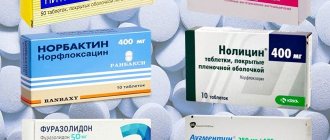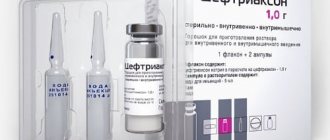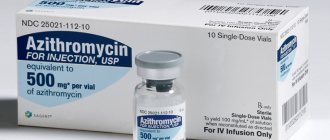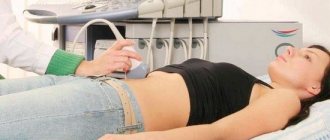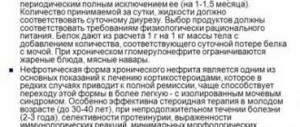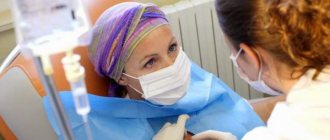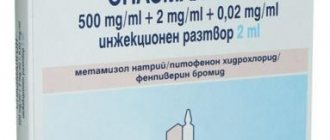One of the most popular and effective broad-spectrum antibiotics is Ceftriaxone, the side effects of which should be studied as carefully as the indications before use. Let's consider what precautions should be taken during treatment with this antimicrobial agent.
Side effects of Ceftriaxone
Taking this antibiotic may be accompanied by allergic reactions, namely: hives, itching and rash. In rare cases, exudative erythema multiforme, bronchospasm, or even anaphylactic shock occurs.
The gastrointestinal tract may react to taking the medicine with diarrhea or, conversely, constipation, as well as nausea, and impaired taste. Sometimes side effects of the antibiotic Ceftriaxone manifest themselves in the form of glossitis (inflammation of the tongue) or stomatitis (painful ulcers on the oral mucosa). Patients may complain of abdominal (constant) pain in the abdomen.
The liver reacts specifically to Ceftriaxone: its transaminases can increase activity, as well as alkaline phosphatase or bilirubin. In some cases, pseudocholelithiasis of the gallbladder or cholestatic jaundice may develop.
According to the instructions, side effects of Ceftriaxone may include impaired renal function, which causes an increase in the level of:
- nitrogenous metabolic products (azotemia);
- creatinine (hypercreatininemia);
- urea.
In urine, in turn, the following may appear:
- glucose (glucosuria);
- blood (hematuria);
- so-called cylinders - casts of proteins or cellular elements (cylindruria).
The amount of urine excreted by the kidneys may decrease (oliguria) or reach zero (anuria).
Hematopoietic system reaction
Ceftriaxone injections can also have side effects on the blood-creating organs, which consist of a decrease in blood cells per unit of blood:
- red (erythrocytes) – anemia;
- white (leukocytes) – leukopenia;
- neutrophil leukocytes – neutropenia;
- granulocytes – granulocytopenia;
- lymphocytes – lymphocytopenia;
- platelets – thrombocytopenia.
The concentration of plasma coagulation factors in a unit of blood may decrease, and hypocoagulation (poor blood clotting) may occur, which can lead to bleeding.
At the same time, in some cases, a side effect of Ceftriaxone is leukocytosis - an increase in white cells in the blood.
Local and other reactions
When an antibiotic is injected into a vein, inflammation of its wall (phlebitis) may develop, or the patient will simply begin to feel pain along the course of the vessel. When the medicine is administered intramuscularly, an infiltrate and painful sensations in the muscle sometimes appear.
Nonspecific side effects of taking Ceftriaxone include:
- headache;
- candidiasis;
- dizziness;
- nosebleeds;
- superinfection (development of antibiotic resistance, causing one infection to develop into another).
Overdose and compatibility with drugs
In case of overdose, symptomatic therapy is carried out. There is no specific antidote that eliminates the effect of Ceftriaxone; hemodialysis is ineffective. Therefore, you should be very careful with the dosage of the medicine - this should be controlled by a doctor.
Ceftriaxone also has other disadvantages: it interferes with the production of vitamin K, because, like any antibiotic, it suppresses the intestinal flora, so you should not take non-steroidal anti-inflammatory drugs with it - this can increase the risk of bleeding. The medicine is incompatible with ethanol, therefore drinking alcohol during treatment is contraindicated.
Aminoglycosides and Ceftriaxone, acting together, enhance each other's effect (synergy) against gram-negative microbes.
Source womanadvice.ru
Many people are interested in whether Ceftriaxone has side effects. Antibiotics and antimicrobials are quite widely used in the drug treatment of various inflammatory processes and infectious diseases. Their composition is constantly being improved, making the treatment of infectious diseases more effective. But the question of their side effects is still of great concern to both doctors and patients. A lot of research has already been carried out, and there are ongoing discussions in medical circles. One thing is clear for now: a more effective method of fighting infections than antibiotics has not yet been found. It is worth carefully studying the effects of drugs on the body and using them only as prescribed by a doctor.
A popular third-generation broad-spectrum antibiotic is Ceftriaxone. As most doctors note, the side effects of this drug have a small percentage of manifestations and they are all reversible. According to statistics, only 3 patients out of 100 experience unpleasant consequences of taking Ceftriaxone. Moreover, they all occur in a very mild form. And only 0.5% of patients had severe reactions.
Treatment of pyelonephritis with ceftriaxone
After entering the patient’s body, this drug quickly reaches the site of kidney damage, triggers a series of biochemical processes, during which the formation of cell membranes in bacteria is blocked. This leads to metabolic disorders in the causative agents of pyelonephritis and they die from their own toxins.
In addition to pyelonephritis, Ceftriaxone is also prescribed for bronchitis, pneumonia, otitis, sore throat, purulent processes in the lungs, streptoderma, cystitis, prostatitis, gonorrhea, endocarditis, meningitis, peritonitis, vaginitis, syphilis and other diseases caused by pathogenic bacteria sensitive to the drug.
Ceftriaxone is active against a large number of microorganisms : streptococci, staphylococci, enterobacteria, E. coli, Haemophilus influenzae, Klebsiella, Moraxella, Neisseria, Morganella, Salmonella, Proteus, Yersinia, Shigella, Treponema pallidum, Clostridia, Peptococcus, Fusobacteria, Bacteroides and many others.
How much to inject ceftriaxone for kidney inflammation
Ceftriaxone (powder) is a medicine used to eliminate infectious diseases caused by pathogenic and opportunistic microorganisms. The drug has contraindications and side effects, so it should not be used without a doctor's prescription.
Ceftriaxone (powder) is a medicine used to treat infectious diseases.
Pharmacodynamics
Ceftriaxone belongs to the 3rd generation cephalosporin group of antibacterial agents. Intended for intramuscular and intravenous administration.
The active substance inhibits the growth and reproduction of bacteria and also promotes their death. This becomes possible due to the cessation of the production of proteins necessary for the construction of the membranes of microorganisms.
Ceftriaxone is not broken down by beta-lactamases produced by resistant bacteria.
Pharmacokinetics
When administered by injection, it is quickly distributed throughout the tissues and fluids of the body. Bioavailability approaches 100%. The highest concentration of antibiotic in the blood is detected 120-180 minutes after administration.
In case of inflammation of the membranes of the brain, Ceftriaxone easily overcomes the blood-brain barrier. 50% of the drug leaves the body with feces. The remainder is excreted in the urine.
The half-life is 8 hours.
The active substance Ceftriaxone inhibits the growth and reproduction of bacteria and also promotes their death.
Contraindications
Limitations for the use of antibacterial agents are the presence of individual sensitivity to cephalosporin drugs. In order to determine whether contraindications exist, it is necessary to conduct a skin test.
To do this, a small amount of the active substance is injected under the patient's skin. The injection site is monitored for 30 minutes.
If there are no allergic manifestations, expressed in redness of the injection site, itching or rash, then pyelonephritis can be treated with Ceftriaxone.
Indications for use of Ceftriaxone powder
The drug is prescribed for:
- septicemia;
- inflammation of the membranes of the brain;
- abdominal infections (peritonitis, cholecystitis, intestinal infections);
- purulent lesions of bones and cartilage (septic arthritis, osteomyelitis);
- infectious diseases of soft tissues (furunculosis, pyoderma, secondary infection of allergic and herpetic eruptions, erysipelas);
- prevention of opportunistic infections in patients with immunodeficiency;
- early and late stages of tick-borne borreliosis (chronic migratory erythema);
- gynecological infections (endometritis, cervicitis, salpingo-oophoritis);
- urinary tract infections;
- inflammatory diseases of the respiratory system (sore throat, sinusitis, bronchitis, pneumonia);
- uncomplicated gonorrhea;
- prevention of postoperative complications;
- inflammation of the middle part of the auditory canal.
For cystitis
The drug is used for catarrhal inflammation of the mucous membranes of the bladder caused by bacteria:
- coli;
- Escherichia;
- klebsiella;
- Pseudomonas aeruginosa;
- enterobacteria.
For urethritis
Indications for the use of the drug are inflammatory processes in the urethra caused by gonococci and representatives of intestinal microflora.
Indications for use of the drug are inflammatory processes in the urethra.
For pyelonephritis
Ceftriaxone is prescribed for bacterial inflammation of the renal pelvis. The disease should not be accompanied by severe renal dysfunction.
What is pyelonephritis?
The disease begins with a single inflammation of the kidney structures, such as the calyx and pelvis, but later, if no efforts are made to cure the disease, the bacteria spread further, which intensifies the symptoms of the disease and complicates treatment measures. Most often, pyelonephritis occurs as a result of pathogenic bacteria entering the body, such as:
- Escherichia coli - this type of microorganism is pathogenic and opportunistic, that is, it lives in the human digestive system, but is sometimes involved in the onset of infectious kidney damage;
- Proteus is a microorganism that arises as a result of improper hygienic conditions, most often in the kitchen and rooms with rare sanitary treatment;
- Enterococcus is a bacterium that is one of the bacteria of the digestive environment, but at some point changes its location and provokes an inflammatory process.
https://www..com/watch?v=LFZexKxkVVg
What usually happens is that the cause of the disease is not one, but several pathogenic bacteria. Sometimes fungal formations are layered on them.
Bacteria can settle in any of the organs in the human body and pass through the constantly circulating blood to the renal system; this type of transmission of infection is called hematogenous.
Women have a more developed ascending pathway for attacking bacteria. Since, due to the anatomical structure of a woman's urethra, it is smaller and wider than a man's, it attracts many microorganisms that can harm human health.
The third most common route of infection is lymphatic.
It is important to note that the disease can occur in two stages: acute and chronic. When the disease worsens, a person enters an acute stage, characterized by pronounced symptoms.
If measures are not taken to eliminate the disease, then it will become chronic.
Treatment in such cases requires long-term medical intervention and a special diet.
Antibiotics prescribed for pyelonephritis can be used in various forms: orally, infusion, or intravenously.
If in outpatient urological practice it is quite possible to take drugs orally, in complicated forms of pyelonephritis it is preferable to administer antibacterial drugs intravenously, for a more rapid development of the therapeutic effect and increased bioavailability.
After feeling better and clinical manifestations disappearing, the patient is transferred to oral administration. In most cases, this occurs within 5–7 days from the start of treatment. The duration of therapy for this form of pyelonephritis is 10-14 days, but it is possible to extend the course to 21 days.
Sometimes patients ask the question: “Can pyelonephritis be cured without antibiotics?”
Perhaps a fatal outcome did not occur in some patients, but the process would become chronic (transition to a chronic form with frequent relapses) would be ensured.
In addition, we should not forget about such dangerous complications of pyelonephritis as bacteriotoxic shock, pyonephrosis, renal carbuncle, and apostematous pyelonephritis.
These conditions in urology are urgent, requiring immediate response, and, unfortunately, the survival rate in these cases is not 100%.
Therefore, experimenting on yourself, given the availability of all the necessary means in modern urology, is, to say the least, unreasonable.
Application and dosage
For intramuscular use, the powder must be diluted with 1 ml of a 1% lidocaine solution. For parenteral use, the drug is mixed with saline. The dosage depends on the type of disease:
- Kidney and urinary tract infections. The recommended daily dose of Ceftriaxone is 1-2 g. It is divided into 2 applications. In case of severe disease, the dose is increased to 4 g. The dose for children under 12 years of age is set at 25-50 mg/kg. The course of treatment lasts 7-14 days.
- Tick-borne borreliosis. The drug is administered once a day in an amount of 2 g. Treatment lasts 2 weeks.
- Bacterial damage to the meninges in children. The initial single dose is 100 mg/kg. Injections are given once a day.
- Acute gonorrhea. 250 mg of Ceftriaxone is administered intramuscularly once.
- Prevention of postoperative complications. 1-2 g of the drug is administered 1-1.5 hours before the intervention.
For intramuscular use, the powder must be diluted with 1 ml of a 1% lidocaine solution.
Treatment of cystitis
Cystitis is a female disease that affects the bladder and causes its inflammation.
This happens because the female urinary tract is very short and there is a high probability of various bacteria getting there.
It is very important for the female body not to retain urine and empty the bladder on time; this will reduce the likelihood of infections and prevent the occurrence of many diseases.
But if it was not possible to avoid inflammation, you will have to resort to antibacterial therapy. Third generation cephalosporins cope well with various types of infections. Ceftriaxone is a broad-spectrum antibiotic that treats urogenital conditions, but it must be prescribed by your doctor.
No contraindications or side effects have been identified based on studies. If you are intolerant to the components of the antibiotic, it is worth replacing it with a drug from a different series.
Source: https://lift74.ru/skolko-kolot-ceftriakson-pri-vospalenii-pochek/
Contraindications for use
This drug is quite toxic in some conditions and concomitant diseases, so its use is contraindicated in :
- Allergies to Ceftriaxone and other cephalosporins, as well as to penicillins;
- Pregnancy up to 12 weeks (first 3 months);
- Breastfeeding period;
- Kidney failure;
- Liver failure;
- Ulcerative lesions of the gastrointestinal tract;
- History of the development of inflammation of the small and large intestines (colitis and enteritis) as a reaction to taking cephalosporins;
- Premature babies.
Side effects from administration
Ceftriaxone has a large list of possible side effects - for example, with injection therapy the following are most often observed:
- attacks of nausea, rarely ending in vomiting;
- heartburn, frequent belching;
- rash on the skin accompanied by itching;
- Quincke's edema;
- dizziness;
- spontaneous increase in body temperature;
- intestinal disorder - colic, diarrhea;
- spasms of the lower extremities;
- fungal diseases such as thrush, candidiasis;
- drug-induced hepatitis;
- pain in the abdominal area (anatomical projection of the location of the stomach);
- general weakness, feeling very tired;
- hematuria (presence of blood in the urine);
- bronchospasms;
- violation of the blood formula.
The appearance of any of the listed symptoms is a reason to refuse further use of the antibiotic. Patients are often prescribed symptomatic therapy to reduce the severity of side effects.
Directions for use and doses
Ceftriaxone is for injection only (intravenous and intramuscular). The solution with the drug must be prepared immediately before use. To do this, add 2 ampoules of lidocaine 1% to one bottle of powder for an adult woman with pyelonephritis, shake thoroughly until completely dissolved and a homogeneous transparent liquid is obtained. Next, the drug is drawn into a sterile syringe.
- Intramuscularly , 1 g of medication is injected deep into the gluteal muscle (contents of 1 bottle). The next day, it is recommended to give the injection to the opposite buttock. The duration of treatment is on average 7-10 days.
- Intravenous administration of the drug in case of inflammation in the kidneys is used quite rarely. To do this, add 10 ml of water for injection to the vial with the substance and inject 1 g of Ceftriaxone slowly (over 4-5 minutes).
The only criterion for discontinuing the drug is normalization of body temperature, reduction of symptoms of pyelonephritis and restoration of the woman’s laboratory parameters, plus 3-4 days after this.
Reviews from doctors and patients
When treating cystitis with ceftriaxone, patient reviews are mostly positive. The drug is highly effective and quickly relieves signs of inflammation. Some comments note adverse reactions to the drug in the form of dizziness, migraines, gastrointestinal upset or allergic skin rashes. Separately, the drug was well tolerated.
Doctors clearly recognize the compliance of the high properties of the drug with the declared characteristics. According to experts, no one is immune from the development of a negative reaction of the body to such a powerful drug, but with proper administration and compliance with certain dosages and duration of the course of therapy, this possibility is minimal.
In any case, in case of severe side effects, there is always the possibility of replacing ceftriaxone with an antibiotic with a “milder” effect and similar properties.
Use during pregnancy and breastfeeding
During the formation of organs in the fetus, in the first 12 weeks of pregnancy, the use of this drug is extremely contraindicated ; it can cause disturbances in the development of the child and the occurrence of serious abnormalities, even death.
In the subsequent weeks of pregnancy, the drug can be used according to the woman’s indications - if the risk of her disease is higher than the possible risk to the child.
During the period of lactation and the mother absolutely needs treatment, breastfeeding must be abandoned for the entire time of use of Ceftriaxone in order to prevent disturbances in the growth and development of the baby.
Features of use
In the presence of pathologies of renal function in patients requiring treatment for pyelonephritis, a reduction in the dose of Ceftriaxone is not required.
In case of liver dysfunction there is also no need for dosage adjustment.
When renal and hepatic dysfunction are combined, regular monitoring of the level of Ceftriaxone in the patient's blood is necessary. Based on its indicators, the dose of the drug is adjusted.
It is very important for patients to follow the treatment regimen for pyelonephritis prescribed by the attending physician, since changing the dosage and shortening the therapeutic course can lead to undesirable consequences.
Side effects
Side effects from the use of Ceftriaxone do not occur often. The most common of them are the following:
- Nausea accompanied by vomiting;
- Diarrhea (diarrhea);
- Drug-induced hepatitis;
- Quincke's edema;
- Itchy skin rash of various types;
- Anaphylactic shock;
- Increased activity of liver enzymes in laboratory parameters;
- Fungal infection of the body (candidiasis, thrush); inflammatory changes in the veins during drug administration (injection phlebitis);
- Convulsions;
- Decrease in blood cells;
- Dizziness;
- Increased body temperature;
- Headache;
- General weakness;
- Abdominal pain;
- Feeling of a rush of blood to the face, to the head;
- Presence of blood in the urine (hematuria);
- Bronchospasms.
The occurrence of any of the symptoms requires immediate discontinuation of the drug , contacting your doctor and symptomatic therapy.
With an overdose of Ceftriaxone over a long period of time, changes in blood composition occur - hemolytic anemia develops and the number of leukocytes, neutrophils and platelets decreases. For treatment, it is recommended to immediately stop using the drug and prescribe symptomatic medications.
Local reactions
Ceftriaxone is administered into the patient's body only through intramuscular injections or intravenous infusions.
The high activity of this antibiotic, which causes severe tissue irritation, does not allow its use in the form of tablets or capsules. The instructions for use of Ceftriaxone state that the administration of this drug is painful and causes local reactions. Sometimes phlebitis occurs - inflammation of the venous wall, which can be prevented by slow administration of the drug. After injection, a lump may form under the skin.
In what cases is Ceftriaxone recommended?
The antibiotic is used for severe forms of cystitis. Most often, Ceftriaxone is prescribed:
- If there is no positive effect from using other means;
- During an exacerbation of cystitis, accompanied by acute pain and difficulty urinating;
- With rapid progression of the inflammatory process;
- When concomitant diseases appear: diabetes mellitus, kidney dysfunction, urolithiasis.
The medicine is used to eliminate other infectious pathologies of internal organs. However, most often the antibiotic Ceftriaxone is prescribed before or after surgery. See also in what cases it is better to take Tsiprolet.
Sources used:
- https://mycistit.ru/lekarstva/ceftriakson
- https://urohelp.guru/lekarstva/ceftriakson-ot-cistita.html
- https://daohotei.com/medicina/cistit/tseftriakson
- https://uromir.ru/vospalenie-mochevogo-puzyrya/lekarstva/ceftriakson-pri-cistite.html
- https://cistitus.ru/lekarstva-proceduri/ceftriakson-pri-cistite.html
- https://1labhealth.ru/tsistit/lekarstva/tseftriakson-pri-lechenii-tsistita-u-zhenshhin.html
- https://cistit911.ru/lekarstva/tseftriakson-pri-tsistite-dozirovka-primenenie.html
- https://prostatainfo.ru/prochee/tseftriakson-pri-tsistite-u-zhenshhin.html
Advantages and disadvantages
The medicinal composition belongs to the group of first-generation cephalosporins and has an antibactericidal effect. After injection, it penetrates into the blood quite quickly, about ninety percent of the composition interacts with plasma proteins, the half-life is from 8 to 12 hours. The kidneys are mainly involved in this process. Another advantage is that the medicine began to be produced in the form of capsules for oral use.
The disadvantages include the fact that the drug can disrupt the microflora of the gastrointestinal system, so you will have to use probiotics along with it.
Treatment regimen and dosage
The antibiotic is administered only intramuscularly and intravenously. The dosage of Ceftriaxone for detected cystitis is determined strictly by the attending physician, taking into account the severity of the inflammatory process, the age category of the patient and the presence of concomitant pathologies. The course of therapy with Ceftriaxone is also prescribed by a specialist and, as a rule, lasts from 1 to 2 weeks.
The dosage of the drug "Ceftriaxone" is usually as follows:
- adults and children over 12 years old - 1–2 g of Ceftriaxone per day;
- newborns up to 2 weeks of age - 0.020–0.050 g/kg body weight per day;
- children under 12 years of age - 0.050–0.080 g/kg body weight.
The dose of Ceftriaxone for the treatment of cystitis is administered once, but in some cases it can be divided into 2 doses (the same time interval must be observed before the first and second administration). In extremely severe forms of the disease or in case of life-threatening complications for the patient, the dosage for an adult is increased to 4 g of Ceftriaxone per day, depending on how many days the therapy lasts.
For intravenous injections, the powder from the ampoule is diluted with water for injection; for intramuscular injections, lidocaine is used. The amount of solvent depends on the dose of Ceftriaxone prescribed by the doctor.
Description and mechanism of action of the antibiotic
Ceftriaxone is an antibiotic that belongs to the group of third-generation cephalosporins and has a wide spectrum of action, which allows its use for cystitis in women. The main properties of the product are its high effectiveness against bacteria, microbes and fungi. As additional qualities, it is worth noting the drug’s ability to fight the inflammatory process and exhibit antiviral and antiseptic activity. These properties are not expressed to such a significant extent that other specialized drugs should be abandoned, but they are also sufficient to prevent septic lesions and further spread of the source of inflammation.
The synthetic product is produced in the form of a powder from which a medicinal solution is prepared. It is used exclusively for the treatment of an existing disease; the drug is not suitable for prevention. The desired effect is achieved by creating a deficiency of components in the structure of bacterial cell membranes, which leads to their death.
- How to take Furazolidone for cystitis: instructions and reviews
Compatibility with other drugs
When prescribing Ceftriaxone, it is important to tell your doctor about any medications you may be taking. After all, the active components react with each other and lead to unexpected results. For example:
- When this antibiotic is combined with drugs from the NSAID group (non-steroidal anti-inflammatory drugs), as well as with antiplatelet agents, the risk of bleeding increases greatly.
- If you inject Ceftriaxone and simultaneously take loop diuretics or other medications that affect kidney function, you can increase the toxic effect of the antibiotic.
- In the case of combining aminoglycosides and this drug, it is possible to achieve higher therapeutic results in treatment.
Ceftriaxone should not be combined with other antimicrobial drugs, and it is strictly forbidden to drink alcohol or alcohol infusions simultaneously with the course of therapy.
Video: Ceftriaxone, Bicillin 3 - dilution of antibiotics.
Indications
Doctors determine the need to use Ceftriaxone in the following cases:
- when there is no result of therapy with gentle treatment;
- intense pain in the patient, pronounced symptoms of an inflammatory or infectious process;
- the appearance of pyelonephritis as a complication;
- recurrent forms of pathology;
- combination of cystitis and other diseases of internal systems;
- with implants installed in the pelvic organs;
- for the treatment of children under 15 years of age, pregnant women and the elderly.
There are other infectious pathologies for which Ceftriaxone injections are also considered a good method of therapy:
- Diseases of the digestive system and biliary tract.
- Inflammatory processes of the respiratory tract.
- Infections of joints and bone tissue.
- Bacterial skin lesions.
- Meningitis.
- Pyelonephritis.
- Endocarditis.
- Some sexually transmitted diseases.
- For disinfection of wound and burn surfaces.
- In the postoperative period to prevent infection of the treated tissues.
But in each case, only the attending physician can determine whether it is necessary to prescribe this antibiotic or use some other medicines. Self-administration of Ceftriaxone for cystitis is prohibited.
How is the drug used for cystitis?
The drug is available in powder form, diluted for injection. They are done intramuscularly or, which is extremely rare, intravenously. The dosage is selected taking into account the stage of the pathology, its intensity, the age category of the patient and other important features. If you follow the manufacturer's recommendations, the treatment will look like this:
- For adults against cystitis, 1-2 grams of the drug is administered once a day. You can distribute this amount over 2 times, keeping an interval of 12 hours from injection to injection.
- In case of significant deviations and severe signs of the disease, the specialist has the right to increase the amount of medicine to 4 grams, but this is allowed only once during the entire therapeutic course in order to quickly begin the process of suppressing pathogenic microflora.
- Children whose age category has not reached 12 years and whose body weight does not exceed 40 kilograms are not recommended to use this antibiotic. But there are times when the doctor prepares an individual dosage. Typically, it consists of 20-80 mg per kilogram of body weight.
The therapeutic course can last from 1 to 2 weeks.
Ceftriaxone powder is diluted immediately before use, for which Lidocaine or a special medical solution is used. In the first option, the injection is given intramuscularly, there is no pain. A very important condition is to follow the rules for using the right amount of liquid to dissolve the powder.
It is not advisable to treat pregnant women for cystitis with this remedy, but there are cases when you simply cannot do without it. The fact is that such a medicine can relieve the patient of the disease quickly enough, and the treatment will not be accompanied by negative manifestations. The course of therapy lasts from 7 to 10 days.
The half-life of an antibacterial drug that passes into breast milk lasts about seventeen hours. This means that during the period of use of this medicinal composition, it is best to temporarily stop feeding. But during the observation process, it was found that during the period of taking the medicine and feeding the baby, no negative effect of the medicine on the baby was detected.
Many doctors confidently state that the use of such an antibiotic during lactation is allowed, but precautions should be taken and periodically replacing some milk feedings with mixtures of artificial origin.
Effective treatment of cystitis
The disease develops due to the penetration of pathogenic microflora into the bladder, after which an inflammatory process occurs.
The fair half of humanity experiences cystitis more often than the stronger sex, due to the structural features of the female genitourinary system. The urethra (urethra) in women is much wider and shorter, and is located near the anus. The first signs of acute cystitis are severe cutting pain in the lower abdomen and painful urination. The woman begins to empty her bladder frequently, urine comes out in small portions, and various impurities (blood, pus, sand) may be present in the urine. The smell of urine becomes unpleasant and the color becomes cloudy. Every time after going to the toilet, the patient has a feeling of an incompletely emptied bladder.
A sick woman feels severe weakness, increased body temperature, and sometimes febrile conditions are observed. A dangerous complication of cystitis can be urine retention or its return to the renal ducts - reflux.
A urologist should prescribe therapy for cystitis in women; self-medication in most cases is ineffective and leads to a chronic course of the disease. Only antimicrobial drugs can combat the inflammatory process, which must be taken strictly as prescribed by the attending physician. In severe cases of inflammation, a powerful antibiotic is needed that has a detrimental effect on most microorganisms that cause this disease.
Ceftriaxone has a strong effect and is an antimicrobial drug from the cephalosporin group. Refers to third generation antibiotics. The release form of Ceftriaxone is a white powder, packaged in sterile glass bottles of 0.5, 1 and 2 g. Ceftriaxone is diluted with water for injection or anesthetics (most often lidocaine). The antibiotic is administered parenterally: intramuscularly and intravenously (using a dropper).
The antimicrobial effect of Ceftriaxone is based on its ability to destroy the protein that makes up the cell walls of microorganisms, as a result of which the pathogens die. Ceftriaxone is effective even against those bacteria that secrete penicillinase, a substance resistant to other antibiotics.
"Ceftriaxone" has a detrimental effect on the following microorganisms:
- Gram-positive - staphylococci, streptococci.
- Gram-negative - Escherichia coli and Hemophilus influenzae, Klebsiella, Clostridia, Enterobacteria and Actinobacteria, gonococci, Proteus.
After introduction into the body, Ceftriaxone quickly penetrates bone structures, liquid media and tissues, respiratory tract, urinary system, skin, and cerebrospinal fluid. The elimination of the drug is observed after two days. "Ceftriaxone" effectively fights infectious agents, relieves inflammation and severe pain during exacerbations of cystitis.
- their concentration in urine is high,
- they should not have a toxic effect on the patient's kidneys.
- identify the causative agent of pyelonephritis,
- determine the condition and function of the kidneys,
- determine the state of urine outflow.
- antibiotics (Ampicillin, Amoxicillin, Cefaclor, Gentamicin).
- sulfonamides (Co-Trimoxazole, Urosulfan, Etazol, Sulfadimezin).
- nitrofurans (Furadonin, Furagin, Furazolin)
Which antibiotic is best to take for pyelonephritis? To answer this question, it is necessary to conduct a survey in which
In the occurrence and development of pyelonephritis, the main role is played by bacteria (microorganisms), which primarily affect the tissues of the kidney, its pelvis and calyx, therefore, in the forefront, in the complex treatment of the disease, it is worth using
Although they are prescribed for mild forms of the disease, sulfonamides are rarely used at present.
Prescribed if there is good urine flow and there is no renal failure.
If one of the two conditions is absent, the use of drugs is not used.
Antibacterial drugs have a wide spectrum of action, and their concentration in the patient’s urine is observed (based on clinical studies of drugs) within 10-15 hours.

